Review for Tajomaru: Avenging Blade
Introduction
"Based on Rashomon and In A Grove by Ryunosuke Akutagawa." The last time I wrote that sentence, I was reviewing the classic Rashomon directed by Akira Kurosawa. It's the seminal film that practically pioneered the multiple viewpoint technique of storytelling, with various characters recounting the events of a brutal crime from their own unique perspectives, retelling the same story in wildly different, but equally compelling ways. I must admit that my curiosity was piqued when I heard that filmmakers were dipping into that well again, adapting both Rashomon and In A Grove to the big screen once more, albeit with a 21st century gloss. While Rashomon focused on the crime itself, Tajomaru: Avenging Blade tells the overall story, a period action drama that is heavy on the action, with a lot of romance, and a fair bit of comedy as well. But let us get this clear from the off, Kurosawa this most certainly isn't.
Four children grow up together as friends in feudal Japan. Brothers Naomitsu and Nobutsuna are heirs to the Hatakeyama family, and the duties it holds to the Shogun. Elder brother Nobutsuna is expected to inherit the title, and become deputy to the Shogun, while Naomitsu's duty is to support his brother in all things. That said, they do have a friendly rivalry when it comes to the Grand Councillor's daughter Ako, although it's obviously Naomitsu that she loves. The fourth member of their group is Sakuramaru, a vagabond thief that they encountered stealing food from their household, but a boy that Naomitsu took pity on, and took on as his own servant. But the seeds of ambition, and corruption were sown early on when the Shogun took a personal liking to Sakuramaru.
By the time they are older, this corruption has taken root, with Naomitsu and Ako's love for each other driving Nobutsuna to jealousy. The film follows the events that ensue following the death of her father. Her household and riches will be inherited by whoever marries her, and the Shogun wants that gold. He offers the deputyship to the one that can manage to deliver that, regardless of position in the family. With Naomitsu and Ako in love, it would be a foregone conclusion, except Nobutsuna finally acts on his jealousy. Driven to flee, Naomitsu takes Ako and his retainers into the forest, but Sakuramaru betrays them once more. Only Ako and Naomitsu escape, but they encounter further trouble when the bandit Tajomaru confronts them. The final betrayal occurs when Ako chooses Tajomaru over Naomitsu, only to flee from them both. In the ensuing scuffle, Naomitsu manages to kill Tajomaru. But he has only one path left to him, to pick up Tajomaru's blade, and take on the mantle of the notorious bandit for himself.
Picture
Tajomaru's 1.85:1 anamorphic transfer doesn't draw any complaints, as it is clear, sharp and colourful for the most part. As with most of Manga's live action acquisitions these days, it's a native Film to PAL transfer. The rich colours of the production design and the lush natural scenery is brought out well, and the period detail is served well by the transfer. The action sequences are the film's strong point, while any CGI is understated enough to be invisible. The worst I could say is that there is the odd moment of softness, but that's a minor issue on a really agreeable DVD.
Sound
You have the choice between DD 5.1 and DD 2.0 Japanese, with optional English subtitles. The dialogue is clear throughout; the action comes across well, although it isn't exactly a film to make extravagant use of the surround soundstage, being understated for the most part. By far the most disappointing aspect of the audio is the music, which begins suitably enough with a more classical feel with the period setting. It's when the j-pop and j-rock tunes kick in that you may raise a quizzical eyebrow at the incongruousness of musical styles.
Extras
Manga Entertainment have a new logo! It's fluorescent and it's buzzing. Well it is their 20th anniversary. The disc autoplays with trailers for K20: Legend of the Black Mask, and Kamui: Lone Ninja upon insertion, prior to loading up some nicely animated menus.
On the disc, you'll find a short Domestic Trailer, and a longer Original Japanese Trailer for the film.
More substantial is the 17-minute Making of Tajomaru featurette, which has Japanese voice-over Guy introducing clips from the film, interviews with the cast, and some behind the scenes sneak peeks.
Conclusion
The thing about Kurosawa's Rashomon was that it told the same story from different viewpoints, so you wound up with four different versions of the same story. Apparently a fifth version of the story existed that didn't make it to the film, the crap version. It's the crap version that we get here in Tajomaru: Avenging Blade, although the crime that is at the heart of Rashomon only plays a small part. Tajomaru is a film uncertain of its identity, unsure whether it wants to be a period drama, an epic romance, a cool action film, or even a comic parody. It tries to do everything at once, and as so often happens, it falls flat in the attempt. Worse, a woeful script, dismal dialogue, and histrionic performances hamstring a rather promising story.
It's a film that keeps on stopping and starting, with a rather lengthy flashback sequence showing the four as children, the politicking and backstabbing that arises when Ako's father dies, and questions of gold and inheritance come to the fore. Then there is the sequence where Ako and Naomitsu flee, and Sakuramaru embarks on his orgy of betrayal. The sequence where Naomitsu and Ako encounter Tajomaru feels like yet another story. There's a period where we follow Naomitsu as the new Tajomaru as he goes on his spree of banditry, recruiting a gang. There's his capture and trial… It's a film that delivers in spurts, which makes it difficult to decide whether to watch the screen or the clock.
Incidentally, it's the vignette of banditry that I enjoyed the most, as it descended the closest to parody, as Naomitsu discovered the Robin Hood approach to brigandage, and his adventures with his eclectic band owe more to the kid's TV series Maid Marian and Her Merry Men… Especially when said eclectic band start rapping. In Japanese!
Tajomaru is an object lesson in that source material doesn't guarantee excellence in a film. It takes the same source material that made Rashomon one of the most highly regarded films in Japanese cinema history, and creates something that is at the other end of the scale. Its illogical script, its bizarre character motivations, its reliance on cliché, and above all its excruciating actor performances result in a film that I hasten to forget. The sad thing is that the production values are so high; it's a film that looks gorgeous, when you don't pay attention to the story. It's also remarkably accomplished in its action sequences, and it's very easy to get into the various sword fights and well-choreographed battles. It's just a shame that this effort wasn't put into a story more deserving.
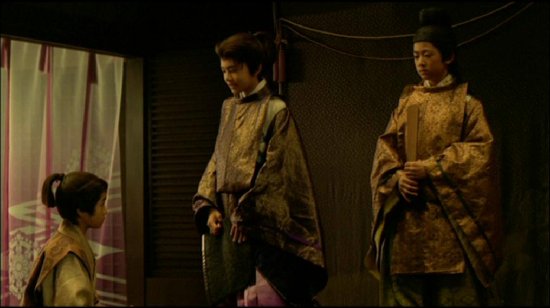
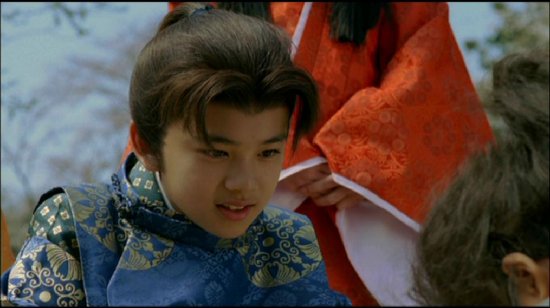


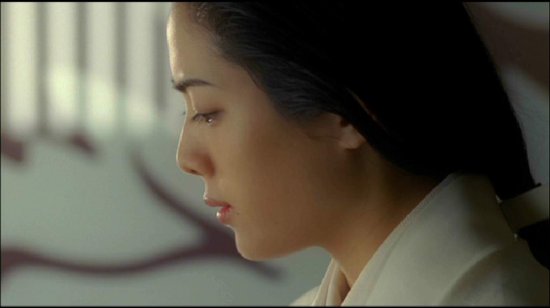
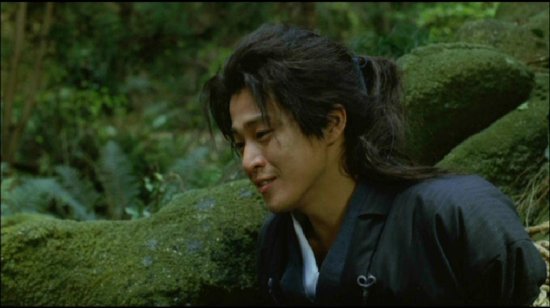
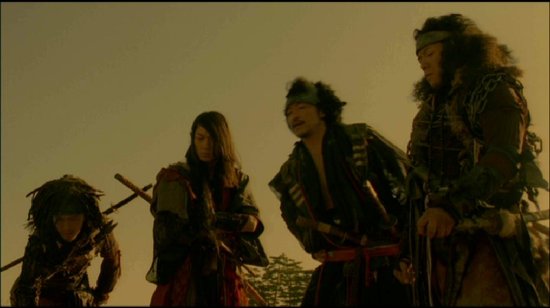
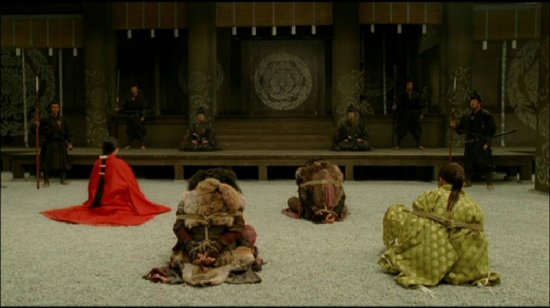
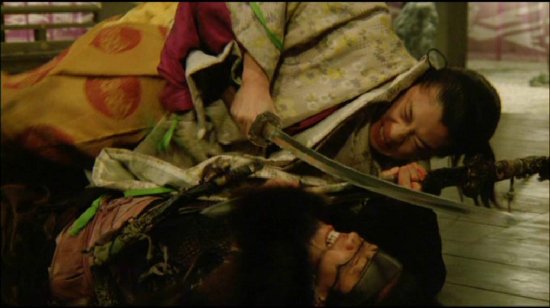
Your Opinions and Comments
Be the first to post a comment!